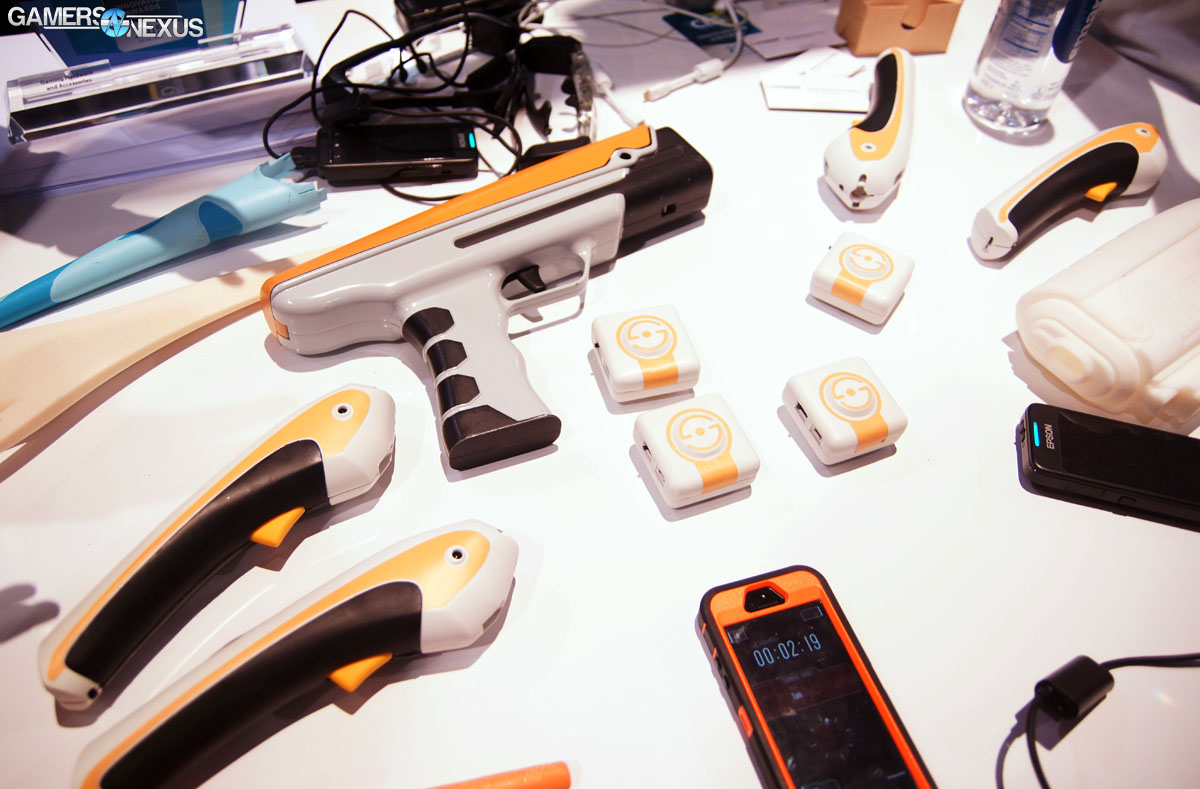Lyteshot Introduces Augmented Reality, Outdoors Games of Assassin, Humans vs. Zombies, & More
Posted on January 15, 2015
A great many cyberpunk novelists would turn green at the AR & VR revolution occurring right now. The two approaches to gaming immersion are vastly different in technological and philosophical scope – we've already recapped the history of virtual reality – but both are critical to the advancement of electronics. Outside of the usual medical and military use cases, both augmented reality and virtual reality components were on tremendous gaming showcase at CES 2015.
Among the multifarious devices we got eyes-on with at the show, Lyteshot was represented by the most impassioned presenters we'd encountered. Lyteshot is a fusion of physical input devices (accelerometer-equipped “wands” and IR-equipped “guns”), mobile applications (games with settings), and Epson AR glasses, the three of which are combined to create a live-action gaming experience disconnected from traditional screens.
There are a few core components of the Lyteshot gaming kit, which is now available via Kickstarter:
- Lyter: A “wand” equipped with an infrared sensor, accelerometer, and blue tooth, each enabling utilization in different types of games (FPS, spell-casting, and melee combat, respectively).
- LytePuck: A small, disc-like object that can be used as an AR enemy spawner, a portal, an attack/defend “hill” for KOTH games, or similar.
- Phones: Using a free mobile application, gamers can initiate a game of “assassin,” effectively a digitally-assisted recreation of the existing assassin FPS-like game. Future iterations will offer a digitally-assisted Humans vs. Zombies (as played on college campuses) and Besiege, a medieval-fantasy conflict wherein players take the role of a wizard, ranger, or warrior.
- Glasses (optional): AR glasses place an unintrusive HUD over the player's vision, showing a compass with target locations on the bottom of the LCD lens. Other UX elements, like player health or shields, are displayed in corners of the viewport.
Intended Uses
Lyteshot is meant to be used with a group of friends who'd like to play a live action game, just like Assassin, HvZ, or even Laser Tag (though we've been encouraged to avoid this comparison for reasons discussed momentarily). Lyteshot will eventually include a gauntlet that houses the player's phone – very Cyberpunk-Dystopian in potential – and the player can then reference their gauntlet as a radar or as a battle progress indicator. AR enemies can spawn in some game modes, each appearing on the phone screen radar. The player then points their weapon in the general direction the phone indicates (so there isn't a requirement of perfect accuracy just yet) to kill the encroaching enemies.
For games that involve strictly human participants, players can battle over a game- or player-designated “flag” (generally established by the LytePuck). Depending on which game is selected, this could be done with fantasy classes (each hosting typical strengths / weaknesses in complement to one another) or FPS gunning. Additional game modes are possible in the future.
It isn't Laser Tag
Lyteshot offers significantly bolstered functionality over even the most expensive Laser Tag equipment. By integrating with mobile devices and AR technology, Lyteshot's scope of gameplay is greatly expanded upon Laser Tag's usual attack / defend base mechanics.
Impressions
Going into the Lyteshot demo, my primary question was one of how my eyes would cope with a HUD being “in the way” of my vision. As it turns out, the HUD doesn't feel too close (or too far) and is generally unrestrictive to the player. To access a gameplay menu, the player can look vertically (about 50 degrees), at which point a menu scrolls down onto the lens. The HUD in its present alpha state is very minimalistic, so if the team sticks with that, I'll be happy. It's primarily used for accessing HP/shield and enemy location information.
Our team felt strongly that the product is innovative and unique, has potential to be fun, but could be expensive enough in its initial production run so as to be unattainable. At $125 for a single LytePuck and Lyter – not an unfair price, but a hefty one to a consumer – locating enough players to create a fun four-player competition could prove challenging. Given the tremendous expense of small order quantity hardware, this is going to be a challenge that will require creative thinking (or marketing) to overcome.
As for the technology itself, we're excited to see where it goes and get hands-on sample time. It's an early step in the right direction for AR, outside gameplay. Lyteshot is even providing 3D printer-compatible files for self-fabrication of skins for the Lyter; an example at the booth included an eerily familiar Halo plasma pistol reproduction.
Learn more here: https://www.kickstarter.com/projects/1450125572/lyteshot-a-sensor-based-mobile-gaming-platform
- Steve “Lelldorianx” Burke.
